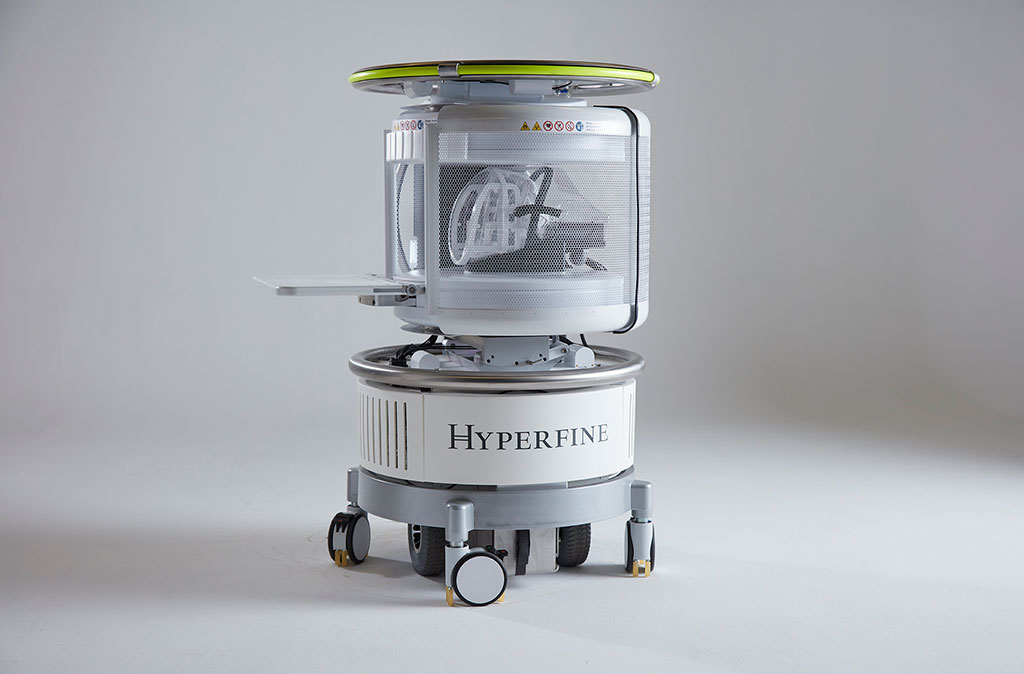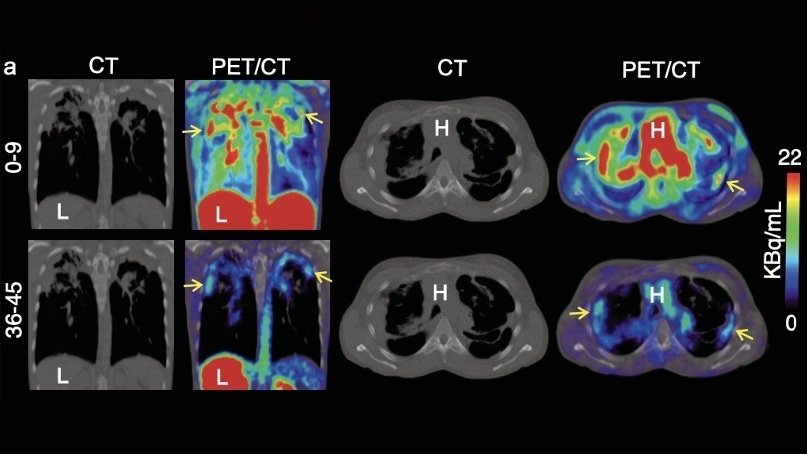POC MRI Helps Evaluate Intracerebral Hemorrhage
|
By MedImaging International staff writers Posted on 09 Sep 2021 |

Image: The Swoop low-field pMRI device (Photo courtesy of HyperFine Research)
A new study confirms that portable magnetic resonance imaging (pMRI) can scan for intracerebral hemorrhage (ICH) at the point-of-care (POC).
Researchers at Yale School of Medicine (New Haven, CT, USA) and Yale New Haven Hospital (YNHH; CT, USA) conducted a study involving 144 pMRI examinations (56 ICH, 48 acute ischemic stroke, 40 healthy controls) taken at the bedside at YNHH from July 2018 to November 2020, and compared them to traditional neuroimaging scans (non-contrast computerized tomography (CT) or 1.5/3 T MRI) to examine the efficacy of the Hyperfine Research (Guilford, CT, USA) Swoop low-field (0.064 T) pMRI device.
Two neuroradiologists evaluated all pMRI scans, with one ICH imaging core lab researcher reviewing the cases of disagreement. The raters correctly detected ICH in 45 of 56 cases (80.4%), and blood-negative cases were correctly identified in 85 of 88 cases (96.6%). Manually segmented hematoma volumes and ABC/2 formula for estimated volumes on pMRI correlated with conventional imaging volumes. Hematoma volumes measured on pMRI at discharge also correlated with manual and ABC/2 volumes. The study was published on August 25, 2021, in Nature Communications.
“There is no question this device can help save lives in resource-limited settings, such as rural hospitals or developing countries,” said senior author professor of neurology and neurosurgery Kevin Sheth, MD, of Yale School of Medicine. “There is also now a path to see how it can help in modern settings. It is of critical importance to continue to collect more data across a range of stroke characteristics so that we can maximize the potential benefit of this approach.”
The Swoop pMRI is a low-field system that features standard permanent magnets that require no power or cooling systems, producing an image using low-power radio waves and magnetic fields instead. The Swoop is controlled via a tablet device, using sequences and protocols selected from a playlist. As a result, the system is 10X lower in weight than current fixed conventional MRI systems, costs a fraction of the price, is highly portable, and plugs directly into a standard electrical wall outlet, with 35X lower power consumption.
Related Links:
Yale School of Medicine
Yale New Haven Hospital
Hyperfine Research
Researchers at Yale School of Medicine (New Haven, CT, USA) and Yale New Haven Hospital (YNHH; CT, USA) conducted a study involving 144 pMRI examinations (56 ICH, 48 acute ischemic stroke, 40 healthy controls) taken at the bedside at YNHH from July 2018 to November 2020, and compared them to traditional neuroimaging scans (non-contrast computerized tomography (CT) or 1.5/3 T MRI) to examine the efficacy of the Hyperfine Research (Guilford, CT, USA) Swoop low-field (0.064 T) pMRI device.
Two neuroradiologists evaluated all pMRI scans, with one ICH imaging core lab researcher reviewing the cases of disagreement. The raters correctly detected ICH in 45 of 56 cases (80.4%), and blood-negative cases were correctly identified in 85 of 88 cases (96.6%). Manually segmented hematoma volumes and ABC/2 formula for estimated volumes on pMRI correlated with conventional imaging volumes. Hematoma volumes measured on pMRI at discharge also correlated with manual and ABC/2 volumes. The study was published on August 25, 2021, in Nature Communications.
“There is no question this device can help save lives in resource-limited settings, such as rural hospitals or developing countries,” said senior author professor of neurology and neurosurgery Kevin Sheth, MD, of Yale School of Medicine. “There is also now a path to see how it can help in modern settings. It is of critical importance to continue to collect more data across a range of stroke characteristics so that we can maximize the potential benefit of this approach.”
The Swoop pMRI is a low-field system that features standard permanent magnets that require no power or cooling systems, producing an image using low-power radio waves and magnetic fields instead. The Swoop is controlled via a tablet device, using sequences and protocols selected from a playlist. As a result, the system is 10X lower in weight than current fixed conventional MRI systems, costs a fraction of the price, is highly portable, and plugs directly into a standard electrical wall outlet, with 35X lower power consumption.
Related Links:
Yale School of Medicine
Yale New Haven Hospital
Hyperfine Research
Latest MRI News
- AI-Assisted Model Enhances MRI Heart Scans
- AI Model Outperforms Doctors at Identifying Patients Most At-Risk of Cardiac Arrest
- New MRI Technique Reveals Hidden Heart Issues
- Shorter MRI Exam Effectively Detects Cancer in Dense Breasts
- MRI to Replace Painful Spinal Tap for Faster MS Diagnosis
- MRI Scans Can Identify Cardiovascular Disease Ten Years in Advance
- Simple Brain Scan Diagnoses Parkinson's Disease Years Before It Becomes Untreatable
- Cutting-Edge MRI Technology to Revolutionize Diagnosis of Common Heart Problem
- New MRI Technique Reveals True Heart Age to Prevent Attacks and Strokes
- AI Tool Predicts Relapse of Pediatric Brain Cancer from Brain MRI Scans
- AI Tool Tracks Effectiveness of Multiple Sclerosis Treatments Using Brain MRI Scans
- Ultra-Powerful MRI Scans Enable Life-Changing Surgery in Treatment-Resistant Epileptic Patients
- AI-Powered MRI Technology Improves Parkinson’s Diagnoses
- Biparametric MRI Combined with AI Enhances Detection of Clinically Significant Prostate Cancer
- First-Of-Its-Kind AI-Driven Brain Imaging Platform to Better Guide Stroke Treatment Options
- New Model Improves Comparison of MRIs Taken at Different Institutions
Channels
Radiography
view channel
AI Generates Future Knee X-Rays to Predict Osteoarthritis Progression Risk
Osteoarthritis, a degenerative joint disease affecting over 500 million people worldwide, is the leading cause of disability among older adults. Current diagnostic tools allow doctors to assess damage... Read more
AI Algorithm Uses Mammograms to Accurately Predict Cardiovascular Risk in Women
Cardiovascular disease remains the leading cause of death in women worldwide, responsible for about nine million deaths annually. Despite this burden, symptoms and risk factors are often under-recognized... Read moreMRI
view channel
AI-Assisted Model Enhances MRI Heart Scans
A cardiac MRI can reveal critical information about the heart’s function and any abnormalities, but traditional scans take 30 to 90 minutes and often suffer from poor image quality due to patient movement.... Read more
AI Model Outperforms Doctors at Identifying Patients Most At-Risk of Cardiac Arrest
Hypertrophic cardiomyopathy is one of the most common inherited heart conditions and a leading cause of sudden cardiac death in young individuals and athletes. While many patients live normal lives, some... Read moreUltrasound
view channel
Ultrasound Probe Images Entire Organ in 4D
Disorders of blood microcirculation can have devastating effects, contributing to heart failure, kidney failure, and chronic diseases. However, existing imaging technologies cannot visualize the full network... Read more
Disposable Ultrasound Patch Performs Better Than Existing Devices
Wearable ultrasound devices are widely used in diagnostics, rehabilitation monitoring, and telemedicine, yet most existing models rely on lead-based piezoelectric ceramics that pose health and environmental risks.... Read moreNuclear Medicine
view channel
New Imaging Solution Improves Survival for Patients with Recurring Prostate Cancer
Detecting recurrent prostate cancer remains one of the most difficult challenges in oncology, as standard imaging methods such as bone scans and CT scans often fail to accurately locate small or early-stage tumors.... Read more
PET Tracer Enables Same-Day Imaging of Triple-Negative Breast and Urothelial Cancers
Triple-negative breast cancer (TNBC) and urothelial bladder carcinoma (UBC) are aggressive cancers often diagnosed at advanced stages, leaving limited time for effective treatment decisions.... Read more
New Camera Sees Inside Human Body for Enhanced Scanning and Diagnosis
Nuclear medicine scans like single-photon emission computed tomography (SPECT) allow doctors to observe heart function, track blood flow, and detect hidden diseases. However, current detectors are either... Read more
Novel Bacteria-Specific PET Imaging Approach Detects Hard-To-Diagnose Lung Infections
Mycobacteroides abscessus is a rapidly growing mycobacteria that primarily affects immunocompromised patients and those with underlying lung diseases, such as cystic fibrosis or chronic obstructive pulmonary... Read moreGeneral/Advanced Imaging
view channel
New Ultrasmall, Light-Sensitive Nanoparticles Could Serve as Contrast Agents
Medical imaging technologies face ongoing challenges in capturing accurate, detailed views of internal processes, especially in conditions like cancer, where tracking disease development and treatment... Read more
AI Algorithm Accurately Predicts Pancreatic Cancer Metastasis Using Routine CT Images
In pancreatic cancer, detecting whether the disease has spread to other organs is critical for determining whether surgery is appropriate. If metastasis is present, surgery is not recommended, yet current... Read moreImaging IT
view channel
New Google Cloud Medical Imaging Suite Makes Imaging Healthcare Data More Accessible
Medical imaging is a critical tool used to diagnose patients, and there are billions of medical images scanned globally each year. Imaging data accounts for about 90% of all healthcare data1 and, until... Read more
Global AI in Medical Diagnostics Market to Be Driven by Demand for Image Recognition in Radiology
The global artificial intelligence (AI) in medical diagnostics market is expanding with early disease detection being one of its key applications and image recognition becoming a compelling consumer proposition... Read moreIndustry News
view channel
GE HealthCare and NVIDIA Collaboration to Reimagine Diagnostic Imaging
GE HealthCare (Chicago, IL, USA) has entered into a collaboration with NVIDIA (Santa Clara, CA, USA), expanding the existing relationship between the two companies to focus on pioneering innovation in... Read more
Patient-Specific 3D-Printed Phantoms Transform CT Imaging
New research has highlighted how anatomically precise, patient-specific 3D-printed phantoms are proving to be scalable, cost-effective, and efficient tools in the development of new CT scan algorithms... Read more
Siemens and Sectra Collaborate on Enhancing Radiology Workflows
Siemens Healthineers (Forchheim, Germany) and Sectra (Linköping, Sweden) have entered into a collaboration aimed at enhancing radiologists' diagnostic capabilities and, in turn, improving patient care... Read more





















